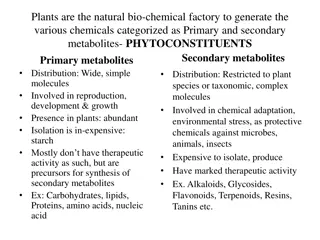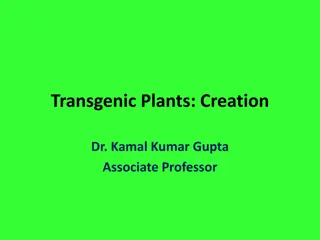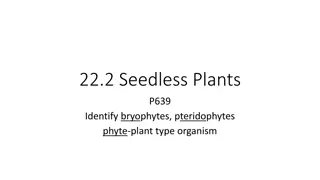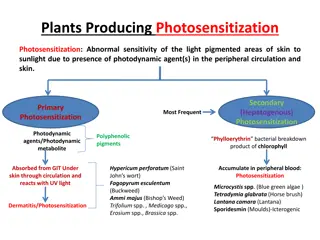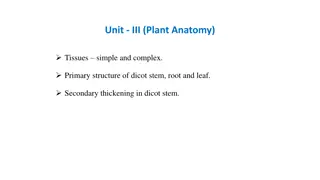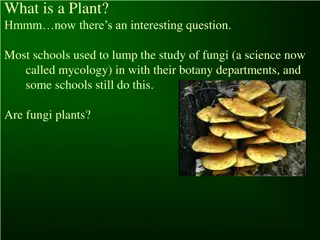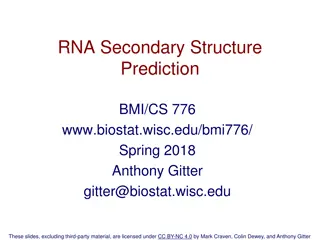Understanding Secondary Growth in Plants: Boerhaavia (Dicot) vs. Dracaena (Monocot)
Secondary growth, resulting from cambial cell division, thickens stems and roots in plants. This process involves cambium, a tissue layer between xylem and phloem, responsible for secondary growth. Cambium ray initials give rise to vascular rays and secondary xylem/phloem. The seasonal activity of cambium varies, with some plants showing year-round activity, mainly in tropical regions. In regions with distinct seasons, cambial activity ceases during unfavorable conditions. Secondary growth in stems and roots has distinct characteristics in dicots and monocots, influencing their structure and functions.
Download Presentation

Please find below an Image/Link to download the presentation.
The content on the website is provided AS IS for your information and personal use only. It may not be sold, licensed, or shared on other websites without obtaining consent from the author. Download presentation by click this link. If you encounter any issues during the download, it is possible that the publisher has removed the file from their server.
E N D
Presentation Transcript
SECONDARY GROWTH AND ANOMALOUS SECONDARY GROWTH IN BOERHAAVIA (DICOT) DRACAENA (MONOCOT)
SECONDARY GROWTH SECONDARY GROWTH IS THE GROWTH THAT RESULTS FROM CELL DIVISION IN THE CAMBIA OR LATERAL MERISTEMS AND THAT CAUSES THE STEMS AND ROOTS THICKNING. IT OCCUR IN EVERGREEN SPECIES THEN IN DECIDIOUS ONE. CAMBIUM A cambium, in plants, is a tissue layer that provides partially undifferentiated cells for plant growth. It is a thin formative layer between the xylem and phloem of most vascular plants that gives rise to new cells and is responsible for secondary growth
STRUCTURE OF CAMBIUM RAY INITIALS ISODIAMETRIC WITH FLATTENED AXIS GIVE RISE TO PARENCHYMATOUS VASCULAR RAYS FUSIFORM INITIAL FORMED FROM THE RADIALS SYSTEM OF CAMBIUM. ELONGATED WITH TAPERING ENDS. SPINDLE IN SHAPE OCCUR IN MIDDLE REGION AND GIVE RISE TO SECONDARY XYLEM AND PHLOEM.
SEASONAL ACTIVITY OF CAMBIUM Cambium of some plants remains active for the entire period of their life, i.e., cambial cells divide and resulting cells mature to form xylem and phloem elements. This type of seasonal activity usually found in the plants present in the tropical regions, and not all plants show cambial activity. Percentage of ringless trees in the rain forests of; India : 75% Amazon : 43% Malaysia : 15%
In regions with definite seasonal climate; seasonal activity of cambium ceased with onset of unfavorable conditions; In Autumn, it enters the dormant state and lasts for the end of summer In Spring, cambium again becomes active. Duration of cambial activity is also affected by day- length e.g., In Robinia pseudoacacia, cambium is dormant under short-day condition.
SECONDARY GROWTH IN STEM The cambium cells formed in circular in cross section from the beginning onwards. The cambial ring is partially primary (fascicular cambium) and partially secondary (interfascicular cambium). Periderm originates from the cortical cells (extra stelar in origin). In Dicot stem, for mechanical support xylem is with comparatively smaller vessels, greater fibers and less parenchyma. More amount of cork is produces for protection
SECONDARY GROWTH IN ROOTS The cambial ring formed is wavy in the beginning and later becomes circular. The cambium ring is completely secondary in origin. Periderm originates from the pericycle (intra stelar in origin). In Dicot root, xylem is with big thin walled vessels with few fibers and more parenchyma. Less amount of cork is produced as root is underground
WOOD THE TERM WOOD IS USED FOR SEC. XYLEM PRODUCED DUE TO ACTIVITY OF CAMBIUM IN THE STEMS OF GYMNOSPERM AND DICOTYLEDON ANGIOSPERM HARD WOOD SOFT WOOD CONTAIN VESSELS WOOD LACKS VESSSELS. ALSO CALLED POROUS WOOD. ALSO CALLED NON POROUS TRACHIEDS ARE ONLY UPTO 5%IN QUANTITY. FOUND IN GYMNOSPERM. TRACHIEDS QUANTITY 90-95% WOOD FIBRES ARE ABUNDANT.
ANOMALOUS SECONDARY GROWTH Anomalous secondary growth is the abnormal secondary growth which does not give rise to the normal pattern of single vascular cambium which forms xylem and phloem rather they posses multiple cambium giving rise to abnormal secondary structures
ANOMALOUS SECONDARY THICKENING IN DRACAENA STEM (MONOCOT) The secondary growth happens by abnormal growth from abnormal cambium in monocot. In monocotyledons normally the vascular bundles are closed. The cambium being absent the secondary growth is absent; but in some plants like Dracaena and Yucca secondary growth takes place. The normal cambium either does not develop. This abnormal cambium may either develop from cortex or pericycle and shows abnormal activity. The young stem has typical structure i.e. epidermis is followed by sclerenchymatous hypodermis. A large number of closely arranged bundles are scattered in ground tissue.
One of the outer layers of cells from the ground tissue becomes meristematic and functions as cambium. The cambium formed in the region which has ceased elongating. The activity of this cambium is more on the inner side and very little on the outside where it forms only parenchyma. On the inner side it forms xylem and parenchyma in alternate patches. The inner parenchymatous cells are called conjunctive tissue. After a short while the activity of cambium on inner side changes and above the xylem it starts forming phloem and then again xylem. The xylem formed earlier has bigger vessels. Around each vascular bundle is developed sclerenchymatous sheath
The cambium after sometime alters its activity and forms xylem on the inner side, at those places where it was previously forming the parenchyma and parenchyma in place of xylem. Similar to earlier case again by change in activity it forms a ring of vascular bundles. Activity of cambium goes on changing regularly and more rings of vascular bundles are formed. Cork cambium is formed below hypodermis and forms cork and cork cambium in normal fashion.
Anomalous Secondary Thickening in Dicot stem (Boerhaavia Stem) The anamolous secondary growth of dicot (Boerhaavia) stem showed following tissues from outside within: Epidermis: Single layered epidermis consists of small, radially elongated cells. Multicellular epidermal hairs arise from some cells. A thick cuticle is present on the epidermis. Some stomata are also present. Cortex: It is well differentiated and consists of few layered collenchymatous hypodermis followed by chlorenchyma. Collenchyma is 3 to 4 cells deep, but generally near stomata
it is only one layered. Chlorenchyma is present inner to collenchyma in the form of 3 to 7 layers. Chlorenchymatous cells are thin walled, oval, full of chloroplasts and enclose many intercellular spaces. Endodermis is clearly developed and made up of many, tubular, thick- walled cells. Pericycle: Inner to the endodermis is present parenchymatous pericycle but at some places it is represented by isolated patches of sclerenchyma.
Vascular System: Vascular bundles are present in three rings. In the innermost ring are present two large bundles; in the middle ring the number ranges from 6 to 14 while the outermost ring consists of 15 to 20 vascular bundles. Vascular bundles of innermost and middle rings are medullary bundles. Vascular bundles are conjoint, collateral and endarch. Two vascular bundles of the innermost ring arc large, oval and lie opposite to each other with their xylem facing towards centre and phloem outwards. Middle ring consists of 6-14 small vascular bundles.
Vascular bundles of inner and middle rings may show a little secondary growth. Phloem consists of sieve tubes, companion cells and phloem parenchyma while the xylem consists of vessels, tracheids and xylem parenchyma. Outermost ring of the vascular bundles contains inter-fascicular cambium which is absent in other two rings.
Cambium develops secondarily from the pericycle and becomes active. It cuts secondary phloem towards outer side and secondary xylem towards inner side. Due to these changes the primary phloem becomes crushed and present next to pericycle. Primary xylem is situated near the pith. Interfascicular cambium also soon becomes active and cuts internally the row of cells which become thick walled and lignified and are known as conjunctive tissue. Pith: It is well developed, parenchymatous and present in the centre.



